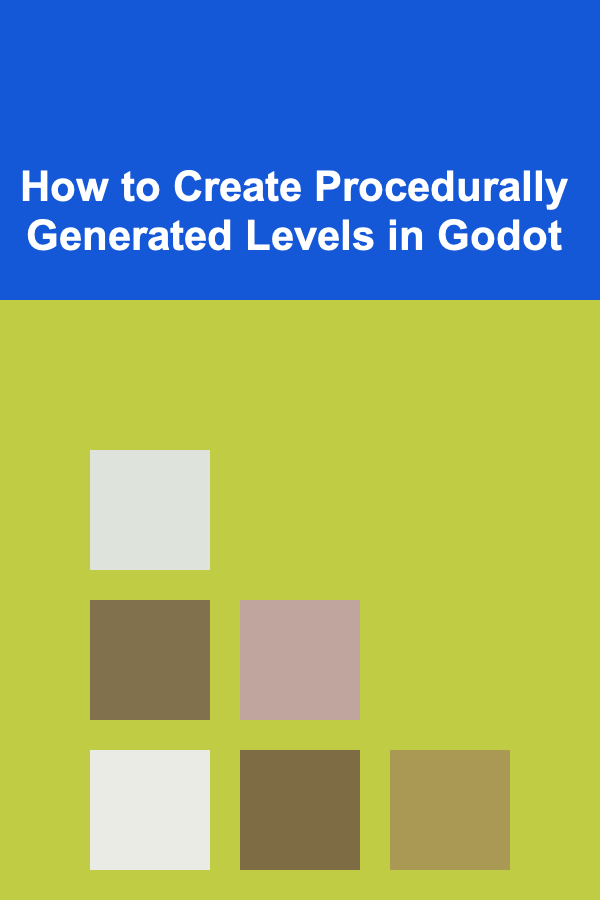
How to Create Procedurally Generated Levels in Godot
ebook include PDF & Audio bundle (Micro Guide)
$12.99$8.99
Limited Time Offer! Order within the next:

Procedural generation is a powerful technique used in video games to create content algorithmically, rather than manually. This technique allows for the creation of vast, dynamic, and varied game worlds that can provide players with unique experiences every time they play. In this guide, we will explore how to create procedurally generated levels in Godot, an open-source game engine that is known for its flexibility and ease of use.
Whether you are making a roguelike dungeon crawler, a survival game with expansive environments, or a platformer with randomly generated levels, Godot provides the tools you need to implement procedural generation in a structured and efficient way.
This guide covers the fundamental principles of procedural generation and how you can implement them in Godot. We'll go over how to create basic algorithms, how to work with the Godot engine, and how to implement your own procedural generation systems.
Why Procedural Generation?
Before diving into the code and techniques, let's understand why procedural generation is useful.
- Replayability: Procedural generation helps create diverse and ever-changing environments, ensuring that players have a new experience each time they play. This is especially valuable in roguelikes, platformers, and open-world games.
- Efficiency: By generating content on the fly, you don't need to design large levels manually. This saves time and allows for infinite or large game worlds without using a large amount of storage.
- Creativity: Procedurally generated content can often create unexpected and interesting designs that might not be considered in traditional level design. The randomness can lead to unique challenges and environments that enhance gameplay.
- Dynamism: Procedurally generated content can be adjusted during runtime, allowing developers to modify levels in real-time based on player behavior or external factors.
Setting Up Godot
Installing Godot
If you don't already have Godot installed, head to the official website to download the latest version of the engine. You can use Godot on Windows, macOS, or Linux, and it supports both 2D and 3D development.
Once Godot is installed, open it and create a new project or open an existing one. We will focus primarily on 2D procedural generation in this guide, but most concepts can be adapted for 3D games as well.
Preparing the Project
To start, create a new scene that will act as your main game scene. You can add a Node2D as the root node, and later, we'll add tiles and objects that make up your procedurally generated level.
Creating a Basic Procedural Generation Algorithm
The core idea of procedural generation is that we generate content at runtime based on a set of rules or random inputs. We'll start with a very simple approach: a grid of tiles that is procedurally generated with random values.
Step 1: Set Up the Tile Map
A TileMap is a useful node in Godot for creating grid-based layouts. It allows you to define a grid of tiles and then dynamically place tiles within it.
- Create a new
TileMapnode under your root node in the scene. - Click on the
TileMapnode, then in the Inspector, set the Cell Size to(32, 32)to define the size of each tile. - Add a new
TileSetin the Tile Set property. ATileSetis a collection of tiles that can be used by theTileMap.
For simplicity, create a few basic tiles (for example, grass and dirt) and add them to the TileSet.
Step 2: Implement Random Tile Generation
Let's write a simple script to randomly generate a grid of tiles.
- Attach a new script to the
TileMapnode. This script will be responsible for generating the level. - In the script, create a function
generate_level()that will randomly place tiles in the grid based on some parameters.
Here's an example of a basic random generation function:
# Define the size of the level
var level_width = 50
var level_height = 50
# Define tile indices for your tileset (ensure you have tiles indexed in your TileSet)
var grass_tile = 0
var dirt_tile = 1
# Randomly generate the level
func generate_level():
for x in range(level_width):
for y in range(level_height):
var tile_type = randf_range(0, 1) < 0.5 ? grass_tile : dirt_tile
set_cell(x, y, tile_type)
Explanation:
- Tile Types : We're using two tiles (
grass_tileanddirt_tile) which correspond to indices in theTileSet. randf_range(0, 1): This function generates a random float between 0 and 1. We use it to decide whether to place a grass tile or dirt tile at each position in the grid.set_cell(x, y, tile_type): This function sets the tile at position(x, y)to thetile_type.
Step 3: Generate the Level on Start
Now that we've created the generate_level() function, we need to ensure that it runs when the game starts. To do this, add a call to generate_level() in the _ready() function:
randomize() # Seed the random number generator
generate_level()
randomize() is a built-in Godot function that ensures the random numbers generated are different each time the game starts.
Step 4: Test the Level Generation
When you run the scene, the TileMap should now be filled with randomly placed tiles. You can adjust the probability or the size of the tiles based on the desired result.
Adding More Complexity to the Generation
The basic random level is a start, but real procedural generation often includes additional complexity to make the levels more interesting. Let's look at a few techniques to enhance the randomness and structure.
1. Perlin Noise for Smoother Results
One common technique in procedural generation is to use Perlin noise (or simplex noise). Perlin noise generates more natural, smooth randomness compared to pure random functions.
Godot has a built-in Noise class that can help us achieve this. Here's how to use it to generate a smoother tile layout:
var level_width = 50
var level_height = 50
var grass_tile = 0
var dirt_tile = 1
# Create a noise instance
var noise = OpenSimplexNoise.new()
# Set the seed for randomness
var seed = randi()
func _ready():
randomize()
noise.seed = seed
generate_level()
# Use Perlin noise to generate the level
func generate_level():
for x in range(level_width):
for y in range(level_height):
var noise_value = noise.get_noise_2d(x, y)
var tile_type = (noise_value > 0) ? grass_tile : dirt_tile
set_cell(x, y, tile_type)
Explanation:
OpenSimplexNoise: This class generates smooth noise, which we use to determine tile placement.get_noise_2d(x, y): Returns a noise value for the given(x, y)position. This value will typically be between -1 and 1, and you can adjust the threshold to decide which tile to place.
2. Room Generation for Dungeon-like Levels
For more structured levels, such as dungeons or caves, we can implement a simple room generation algorithm. Rooms can be created as a set of rectangular areas, and corridors can be added between them.
Here's an example:
var level_width = 50
var level_height = 50
var room_count = 5
var room_min_size = 5
var room_max_size = 10
var grass_tile = 0
var dirt_tile = 1
# A list to hold rooms
var rooms = []
func _ready():
randomize()
generate_level()
func generate_level():
# Start with a fully empty level
fill_with_tile(dirt_tile)
# Generate rooms
for i in range(room_count):
var room_width = randi_range(room_min_size, room_max_size)
var room_height = randi_range(room_min_size, room_max_size)
var room_x = randi_range(0, level_width - room_width)
var room_y = randi_range(0, level_height - room_height)
var room = Rect2(room_x, room_y, room_width, room_height)
rooms.append(room)
# Fill the room with grass
for x in range(room_x, room_x + room_width):
for y in range(room_y, room_y + room_height):
set_cell(x, y, grass_tile)
# Optionally, connect rooms with corridors
create_corridors()
func create_corridors():
for i in range(1, rooms.size()):
var prev_room = rooms[i - 1]
var curr_room = rooms[i]
# Simple corridor from the center of the previous room to the center of the current room
var start = prev_room.position + prev_room.size / 2
var end = curr_room.position + curr_room.size / 2
var dx = end.x - start.x
var dy = end.y - start.y
var steps = max(abs(dx), abs(dy))
for step in range(steps):
var x = int(start.x + dx * step / steps)
var y = int(start.y + dy * step / steps)
set_cell(x, y, grass_tile)
Explanation:
- Room Generation: We randomly create a number of rooms with varying sizes and positions. Each room is represented by a rectangular area that we fill with tiles.
- Corridor Generation: We then connect these rooms by drawing corridors between their centers.
3. Pathfinding and Level Connectivity
Once you generate the layout, especially in dungeon-like games, it's crucial to ensure the player can navigate the world. You can implement pathfinding algorithms like A search* to make sure that the corridors connect all rooms in a way that allows for easy movement.
You could also generate a maze-like structure where rooms are interconnected by passageways.
Conclusion
Procedural generation is an exciting and powerful tool that can lead to highly dynamic and engaging gameplay. In Godot, creating procedurally generated levels is a straightforward process, and as shown in this guide, it can be achieved with just a few lines of code.
By utilizing algorithms like random tile placement, Perlin noise, and room generation, you can create interesting and varied levels for your game. With the flexibility of Godot and its wide array of tools, the possibilities for procedural content generation are virtually endless.
Now that you have the fundamentals, experiment with different algorithms, tweak parameters, and add your own unique features. Happy developing!
Reading More From Our Other Websites
- [Personal Investment 101] Monetize Your Deep Learning Skills: Top Passive Income Ideas
- [Home Storage Solution 101] How to Create a Hidden Storage Space in Your Living Room
- [Personal Financial Planning 101] How to Save for a Home Down Payment in 5 Years
- [Organization Tip 101] How to Reorganize Your Living Room After a Move
- [Trail Running Tip 101] Cold-Weather Conditioning: Building Strength and Endurance for Snow Trail Running
- [Home Lighting 101] How to Light a Large Room Without Overwhelming the Space
- [Home Budget 101] How to Create a Sustainable Home Budget for Long-Term Savings
- [Home Party Planning 101] How to Plan a Formal Dinner Party in Your Own Home
- [Organization Tip 101] The Best Grout Cleaning Tools for a Sparkling Clean Home
- [Home Soundproofing 101] How to Soundproof a Basement for a Peaceful Environment

How to Conduct a Home Security Assessment
Read More
How To Overcome Information Overload
Read More
Managing Anxiety in Everyday Life: A Comprehensive Guide
Read More
How to Use a Book Reading Planner for Genre Exploration
Read More
How to Track Progress with a Yoga Routine Checklist
Read More
10 Pilates To-Do List Ideas for Core Strengthening
Read MoreOther Products

How to Conduct a Home Security Assessment
Read More
How To Overcome Information Overload
Read More
Managing Anxiety in Everyday Life: A Comprehensive Guide
Read More
How to Use a Book Reading Planner for Genre Exploration
Read More
How to Track Progress with a Yoga Routine Checklist
Read More